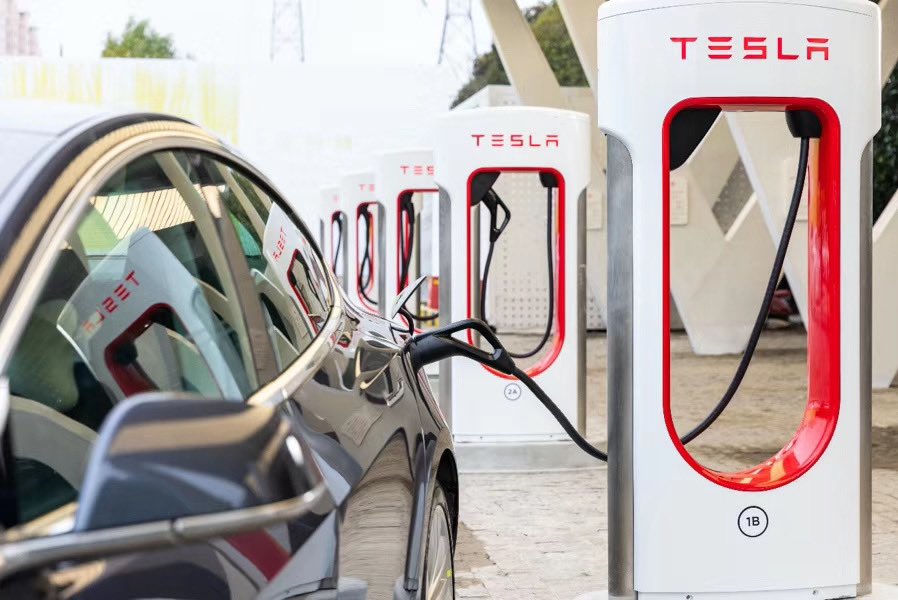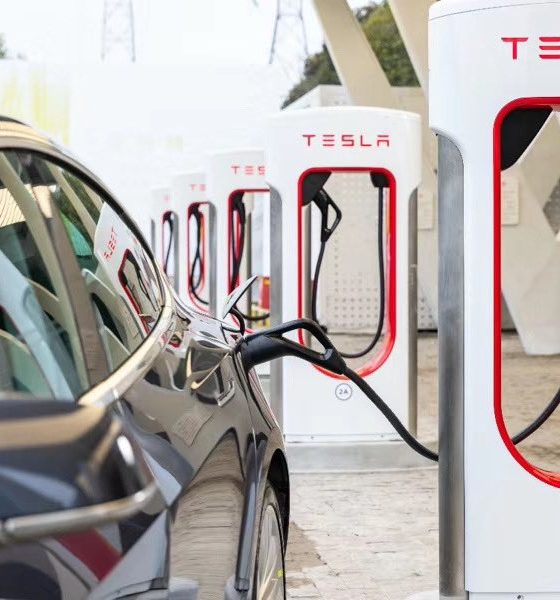

News
Tesla stock spikes on China delivery figures, then cools down for no reason
Tesla (NASDAQ: TSLA) stock spiked nearly 3% this morning after positive news from China that effectively debunked rumors of declining sales figures in May. However, the increase in price was short-lived, as the stock dropped back down to the $600 level after opening at $623.01, despite no negative news being reported regarding Tesla this morning.
Earlier today, the Chinese Passenger Car Association (CPCA) reported Tesla delivered a total of 33,463 vehicles in May. Tesla delivered 21,936 domestically after being produced at Tesla’s Giga Shanghai production facility. The remaining 11,527 were exported to other areas, including Europe, where Tesla started shipping vehicles from China in January.
Tesla China sales rise 30% in May, definitively debunks reports of weak demand
The figures released by the CPCA earlier today directly contradict reports from earlier this month, when The Information stated that an internal source familiar with Tesla’s EV sales in China indicated the electric automaker’s orders had slumped significantly in May compared to April. The figures indicated Tesla had only 9,800 orders in May, suggesting a decrease by as much as 50%. The news sent Tesla stock on a steep decline after the report hit mainstream media, who started to aggregate the story as fact.
The report was met with criticism just a few days later by the CPCA’s Secretary General Cui Dongshu, who said (via Global Times):
“Placed orders cannot equal the sales number in one month. Usually, monthly sales are accumulated units of orders over previous months, so the immediate results in May might not truly reflect whether the recently reported accidents have had any real impact on Tesla’s sales.”
Cui suggested that if Tesla were experiencing decreasing order and sales figures, they wouldn’t be identifiable until July or August.
After Tesla shares spiked this morning on the news of the positive delivery figures in China, the surge cooled down. Analyst Gary Black attributed the drop off to two things: Traders buying on the rumor of low delivery figures, and now selling after shares rose when the CPCA released positive news this morning, or the possibility of Bitcoin’s plummet affecting Tesla’s shares.
1/ Traders bought the China rumor; now selling the news.
2/ #btc collapsing again$tsla https://t.co/NQzxzyoQZE— Gary Black (@garyblack00) June 8, 2021
There is a chance that Jerome Guillen, Tesla’s now-former Head of Heavy Trucking, leaving the company could be affecting the price.
Tesla’s rocky road in China
Tesla has had somewhat of a tumultuous relationship in China over the past few months. After growing concerns of security issues due to Tesla’s external cameras, several State-owned businesses and entities banned the company’s cars on their premises in fear of a security breach that could take pictures of potentially sensitive information. Tesla stated that its cabin cameras are not active, and Elon Musk stated that Tesla’s vehicles were not being used to spy on Chinese entities. “If Tesla used cars to spy in China or anywhere, we would get shut down,” Musk said.
In the following months, Tesla would battle numerous reports of brake failures by numerous owners in China. The most public occurrence of this happening was at the Shanghai Auto Show, where a Model 3 owner claimed her brakes failed and led to an accident. Tesla offered to have a third-party company complete testing on the car to determine the cause of the accident. The owner declined this.
Other owners in China have also come out with similar claims, all of them eventually being debunked or disproven in the following days or weeks. In response to the claims, Tesla created a “Special Handling Team” in China to deter and navigate through false narratives related to the company’s products. Tesla said the team would “meet the demands of car owners and strive to satisfy car owners while complying with laws and regulations.”
Tesla Stock
Tesla shares have dropped 14.49% so far in 2021. Interestingly, Tesla has continued its trend of strong financials and delivery and production performances, citing Quarter-over-Quarter growth in both of the company’s Earnings Calls that have taken place this year. In addition, Q1 2021 proved to be Tesla’s biggest quarter yet in terms of production and delivery figures, despite only manufacturing two of its four currently-offered automobiles. The Model S and Model X lines at Tesla’s Fremont production facility were being retooled during the end of 2020 and the beginning of 2021 as the flagship models were being “refreshed.”
At the time of writing, Tesla shares were trading at $601.16.
Disclosure: Joey Klender is a TSLA Shareholder.

Elon Musk
Elon Musk and Tesla AI Director share insights after empty driver seat Robotaxi rides
The executives’ unoccupied tests hint at the rapid progress of Tesla’s unsupervised Robotaxi efforts.

Tesla CEO Elon Musk and AI Director Ashok Elluswamy celebrated Christmas Eve by sharing personal experiences with Robotaxi vehicles that had no safety monitor or occupant in the driver’s seat. Musk described the system’s “perfect driving” around Austin, while Elluswamy posted video from the back seat, calling it “an amazing experience.”
The executives’ unoccupied tests hint at the rapid progress of Tesla’s unsupervised Robotaxi efforts.
Elon and Ashok’s firsthand Robotaxi insights
Prior to Musk and the Tesla AI Director’s posts, sightings of unmanned Teslas navigating public roads were widely shared on social media. One such vehicle was spotted in Austin, Texas, which Elon Musk acknowleged by stating that “Testing is underway with no occupants in the car.”
Based on his Christmas Eve post, Musk seemed to have tested an unmanned Tesla himself. “A Tesla with no safety monitor in the car and me sitting in the passenger seat took me all around Austin on Sunday with perfect driving,” Musk wrote in his post.
Elluswamy responded with a 2-minute video showing himself in the rear of an unmanned Tesla. The video featured the vehicle’s empty front seats, as well as its smooth handling through real-world traffic. He captioned his video with the words, “It’s an amazing experience!”
Towards Unsupervised operations
During an xAI Hackathon earlier this month, Elon Musk mentioned that Tesla owed be removing Safety Monitors from its Robotaxis in Austin in just three weeks. “Unsupervised is pretty much solved at this point. So there will be Tesla Robotaxis operating in Austin with no one in them. Not even anyone in the passenger seat in about three weeks,” he said. Musk echoed similar estimates at the 2025 Annual Shareholder Meeting and the Q3 2025 earnings call.
Considering the insights that were posted Musk and Elluswamy, it does appear that Tesla is working hard towards operating its Robotaxis with no safety monitors. This is quite impressive considering that the service was launched just earlier this year.
Elon Musk
Starlink passes 9 million active customers just weeks after hitting 8 million
The milestone highlights the accelerating growth of Starlink, which has now been adding over 20,000 new users per day.

SpaceX’s Starlink satellite internet service has continued its rapid global expansion, surpassing 9 million active customers just weeks after crossing the 8 million mark.
The milestone highlights the accelerating growth of Starlink, which has now been adding over 20,000 new users per day.
9 million customers
In a post on X, SpaceX stated that Starlink now serves over 9 million active users across 155 countries, territories, and markets. The company reached 8 million customers in early November, meaning it added roughly 1 million subscribers in under seven weeks, or about 21,275 new users on average per day.
“Starlink is connecting more than 9M active customers with high-speed internet across 155 countries, territories, and many other markets,” Starlink wrote in a post on its official X account. SpaceX President Gwynne Shotwell also celebrated the milestone on X. “A huge thank you to all of our customers and congrats to the Starlink team for such an incredible product,” she wrote.
That growth rate reflects both rising demand for broadband in underserved regions and Starlink’s expanding satellite constellation, which now includes more than 9,000 low-Earth-orbit satellites designed to deliver high-speed, low-latency internet worldwide.
Starlink’s momentum
Starlink’s momentum has been building up. SpaceX reported 4.6 million Starlink customers in December 2024, followed by 7 million by August 2025, and 8 million customers in November. Independent data also suggests Starlink usage is rising sharply, with Cloudflare reporting that global web traffic from Starlink users more than doubled in 2025, as noted in an Insider report.
Starlink’s momentum is increasingly tied to SpaceX’s broader financial outlook. Elon Musk has said the satellite network is “by far” the company’s largest revenue driver, and reports suggest SpaceX may be positioning itself for an initial public offering as soon as next year, with valuations estimated as high as $1.5 trillion. Musk has also suggested in the past that Starlink could have its own IPO in the future.
News
NVIDIA Director of Robotics: Tesla FSD v14 is the first AI to pass the “Physical Turing Test”
After testing FSD v14, Fan stated that his experience with FSD felt magical at first, but it soon started to feel like a routine.

NVIDIA Director of Robotics Jim Fan has praised Tesla’s Full Self-Driving (Supervised) v14 as the first AI to pass what he described as a “Physical Turing Test.”
After testing FSD v14, Fan stated that his experience with FSD felt magical at first, but it soon started to feel like a routine. And just like smartphones today, removing it now would “actively hurt.”
Jim Fan’s hands-on FSD v14 impressions
Fan, a leading researcher in embodied AI who is currently solving Physical AI at NVIDIA and spearheading the company’s Project GR00T initiative, noted that he actually was late to the Tesla game. He was, however, one of the first to try out FSD v14.
“I was very late to own a Tesla but among the earliest to try out FSD v14. It’s perhaps the first time I experience an AI that passes the Physical Turing Test: after a long day at work, you press a button, lay back, and couldn’t tell if a neural net or a human drove you home,” Fan wrote in a post on X.
Fan added: “Despite knowing exactly how robot learning works, I still find it magical watching the steering wheel turn by itself. First it feels surreal, next it becomes routine. Then, like the smartphone, taking it away actively hurts. This is how humanity gets rewired and glued to god-like technologies.”
The Physical Turing Test
The original Turing Test was conceived by Alan Turing in 1950, and it was aimed at determining if a machine could exhibit behavior that is equivalent to or indistinguishable from a human. By focusing on text-based conversations, the original Turing Test set a high bar for natural language processing and machine learning.
This test has been passed by today’s large language models. However, the capability to converse in a humanlike manner is a completely different challenge from performing real-world problem-solving or physical interactions. Thus, Fan introduced the Physical Turing Test, which challenges AI systems to demonstrate intelligence through physical actions.
Based on Fan’s comments, Tesla has demonstrated these intelligent physical actions with FSD v14. Elon Musk agreed with the NVIDIA executive, stating in a post on X that with FSD v14, “you can sense the sentience maturing.” Musk also praised Tesla AI, calling it the best “real-world AI” today.








